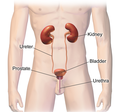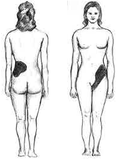Wikipedia:VideoWiki/Urinary tract infection
Definition 1
A urinary tract infection (UTI) is an infection that affects part of the urinary tract.

Definition 2
When it affects the lower urinary tract it is known as a bladder infection (cystitis) and when it affects the upper urinary tract it is known as kidney infection (pyelonephritis).

Symptoms 1
Symptoms from a lower urinary tract include pain with urination, frequent urination, and feeling the need to urinate despite having an empty bladder.

Symptoms 2
Symptoms of a kidney infection include fever and flank pain usually in addition to the symptoms of a lower UTI. Rarely the urine may appear bloody.

Symptoms 3
In the very old and the very young, symptoms may be vague or non-specific.

Cause
The most common cause of infection is Escherichia coli, though other bacteria or fungi may rarely be the cause.

Risk factors
Risk factors include female anatomy, sexual intercourse, diabetes, obesity, and family history.

Diagnosis 1
Diagnosis in young healthy women can be based on symptoms alone.

Diagnosis 2
In those with vague symptoms, diagnosis can be difficult because bacteria may be present without there being an infection. In complicated cases or if treatment fails, a urine culture may be useful.

Treatment 1
In uncomplicated cases, UTIs are treated with a short course of antibiotics such as nitrofurantoin or trimethoprim/sulfamethoxazole. Resistance to many of the antibiotics used to treat this condition is increasing.

Treatment 2
In complicated cases, a longer course or intravenous antibiotics may be needed. If symptoms do not improve in two or three days, further diagnostic testing may be needed.

Treatment 3
Phenazopyridine may help with symptoms.

Prevention
In those with frequent infections, a short course of antibiotics may be taken as soon as symptoms begin or long-term antibiotics may be used as a preventative measure.

Epidemiology 1
About 150 million people develop a urinary tract infection in a given year. They are more common in women than men. Up to 10% of women have a urinary tract infection in a given year, and half of women have at least one infection at some point in their lifetime.

Epidemiology 2
They occur most frequently between the ages of 16 and 35 years. Recurrences are common.

History
Urinary tract infections have been described since ancient times with the first documented description in the Ebers Papyrus dated to c. 1550 BC.
